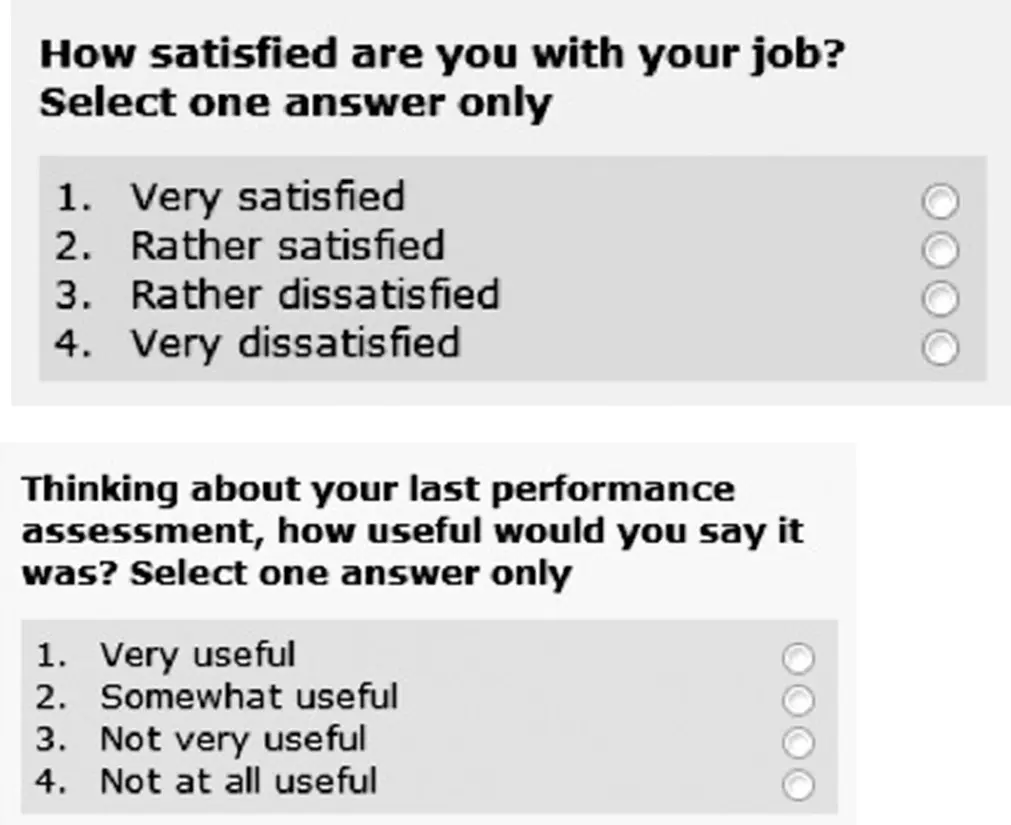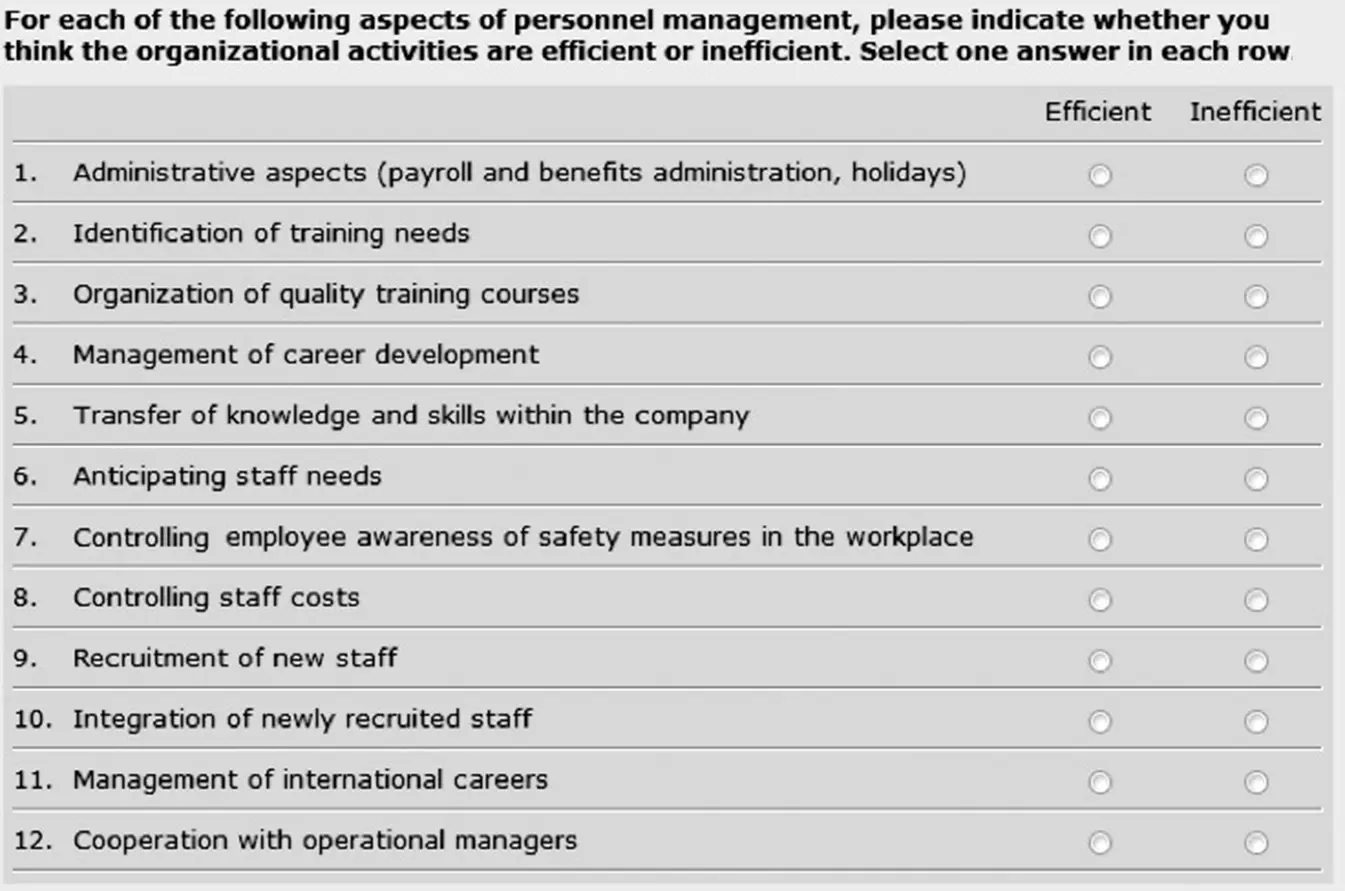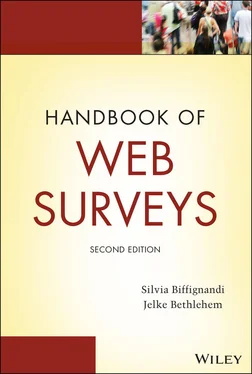It is a mixed‐mode survey including both a web mode and a paper mode. To complete the questionnaire on the web, invitation is to everyone with an e‐mail address. Those without Internet can complete the paper questionnaire.
The enterprise has companies in many different countries. Thus, employees speak different languages. By translating the two questionnaires into the languages spoken in the countries in which the companies are located, language problems are overpassed. For individuals with literacy problems, data collection is via the collaboration of a private voluntary organization.
For the 2007 survey (the starting year of the survey), 22,276 employees were eligible for the survey. In countries with a large number of employees (France, Belgium, Italy, Egypt, Thailand, Morocco), two‐thirds of the white‐collar employees were invited to complete the questionnaire on the web, and one‐third were asked to complete the paper questionnaire. In all remaining countries, all white‐collar employees received a paper questionnaire. For all blue‐collar workers, invitation and completion was paper mode. An exception was France, where blue‐collar workers were receiving an Internet questionnaire.
Online data collection took place in the period from June to September. Data collection in the field ended in October. The results diffusion was in December. The total number of respondents was equal to 12,183. This comes down to a response rate of 54.7%. The response rate of the white‐collar workers (71.5%) was much higher than the response rate of the blue‐collar workers (45%). The response rate of the web respondents was higher than the response rate of the paper questionnaire respondents. Table 2.1shows the response rates by country.
In 2007, the first survey was conducted. This survey is run in the subsequent years in a similar way. The survey turned out to be very informative with respect to the attitudes of employees about their jobs and the company they belong to.
Some examples of (translated) questions in the Italcementi survey are shown below. Figure 2.1contains two questions that use a so‐called Likert scale. They both use a 4‐point scale. When responding to a Likert scale question, respondents specify their level of agreement to a statement. The scale name is after its inventor, the psychologist Rensis Likert .
Figure 2.2shows a so‐called matrix question. Such a question combines a number of single question all with the same type of answer.

Figure 2.1 Questions with Likert scales

Figure 2.2 A matrix question
A web survey is a relatively new data collection technique. The role of the web in conducting surveys is more important due to the spread of the Internet. At first sight, it is an attractive means of data collection because it has many advantages. Among them are costs, timeliness, and the possibility of improving survey quality. Web surveys allow for simple, fast, and cheap access to large groups of potential respondents. Web surveys have quickly become very popular. Recently, due to the high penetration of mobile devices connected to Internet, mobile web surveys are becoming an interesting data collection tool. In practice every web survey becomes a mobile web survey, if access to these devices is not blocked. For these reasons it is important to check how questionnaire works on mobile devices, especially on smartphones. Optimization procedures exist to adapt the questionnaire. Web survey and mobile web surveys deserve also methodological challenges like selection effects and measurement errors. There are ample examples of web surveys not based on probability sampling. It is not always easy to distinguish good surveys from bad. Mobile web surveys encompass even more challenges related to several technical problems like screen and browser characteristics, adaption of the format of the questionnaire, and behavioral issue like when is the questionnaire received. The respondent could be traveling, working, out for a walk, or sporting activity.
This chapter describes the various forms of online data collection, from simple e‐mail surveys to advanced web surveys. It shows how to use web surveys for different target populations, for cross‐sectional data collection, and for longitudinal data collection (panels). It discusses the main reasons for online data collection, the advantages and disadvantages, areas of application, and specific related problems.
Computer‐assisted personal interviewing (CAPI):A form of face‐to‐face interviewing in which interviewers use a laptop computer to ask the questions and to record the answers. Computer‐assisted telephone interviewing (CATI):A form of telephone interviewing in which interviewers use a telephone to ask the questions and to record the answers. Computer‐assisted web interviewing (CAWI):A form of self‐interviewing in which respondents complete the questionnaires on the Internet. CAWI is a synonym for web survey. Cross‐sectional survey:A survey that observes a sample from the target population at one point in time. Objective is to describe the state of the population on that moment in time. Internet survey:A general term for various forms of data collection via the Internet. Examples are a web survey and e‐mail surveys. Included are also forms of data collection that use the Internet just to transport the questionnaire and the collected data. Longitudinal survey:A survey that observes the same sample from the target population at several points in time. Objective is to describe the changes of the population over time. Paradata:Data about the process by which the survey data are collected. Qualitative interview:An in‐person in‐depth interview with respondents that have completed a survey questionnaire. Such an interview aims at uncovering usability problems like difficult questions or cumbersome tasks. Self‐selection survey:A survey for which the sample has been recruited by means of self‐selection. It is left to the persons themselves to decide to participate in a survey. Usability testing:Conducting an experiment to check whether respondents find it easy to complete the web survey questionnaire. Aspects tested include the speed with which the survey task is carried, the number of errors made, and familiarity with the user interface. Web panel:A survey in which the same individuals are interviewed via the web at different points in time. Web survey:A form of data collection via the Internet in which respondents complete the questionnaires on the World Wide Web. The questionnaire is accessed by means of a link to a web page.
1 Exercise 2.1 Which of the following statements does not apply to web surveys?The survey can be conducted faster.The survey can be conducted cheaper.The response rate is high.The survey collects a large number of interviews.
2 Exercise 2.2 In what respect does a web survey resemble a mail survey?They both rely on visual information transmission.They both rely on oral information transmission.They both use computer‐assisted interviewing techniques.They both cost the same amount of time to conduct.
Читать дальше














